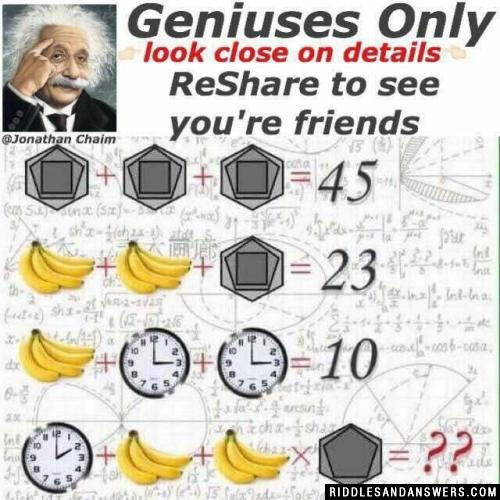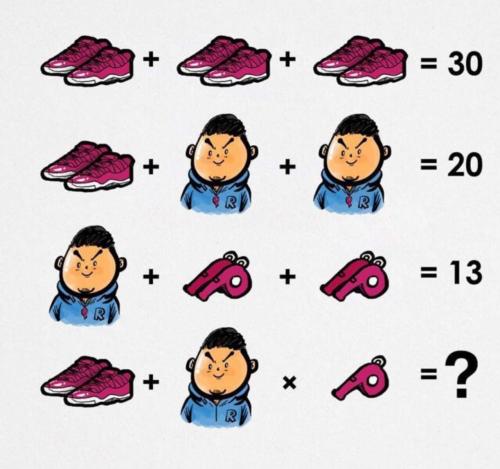Trending Tags
Popular Searches
Black History Riddles Cycle Ball Banana Monkey Kannada Movie Name Riddles Ha I Am Gentle Enough To Soothe Your Skin A Riddles Hot Chocolate Riddles I Have Nine Match Box Sticks And L Would Like Riddle Im Not A Lighthouse Or A Rockbut I Live At The End Of The S Riddles It Has A Trunk But Never Locks It Riddles It Has A Trunk But Never Packs It Riddles Kannada Riddles Murder At Home R Riddles October Hard Riddles Okay Lets Imagine The Following John Had 200k Mary Has 5k And Mark Will Ha Riddles Snow White Asks The Dwarfs A Question 2 Of Them Are Lying And 3 Can Only Say The Truth Bashful Dopey Lies If Sleepy Is Honest Dopey If Happy Doesnt Lie Then Bashful Or Sleepy Do Happy Sneezy Rid Riddles There Is A School Shooting To Keep The Kids Save Riddles What Bet Can Never B Riddles
Feel free to use content on this page for your website or blog, we only ask that you reference content back to us. Use the following code to link this page:
Terms · Privacy · Contact
Riddles and Answers © 2018
Banana Clock Riddle
Hint: 1. Look closely at the clock.
2. Number of Bananas.
3. Some thing regarding the sides of the Shapes figure.
38
Logic :
From 1st the hexagon shape has value 15.
The shape has 15 edges(6 of hexagon,5 of Pentagon and 4 of Square)
From 2nd we get value of one bunch of bananas is 4.
So each banana has value of 1.
From 3rd we get that each clock has value of 3.
Which resembles the time on the clock which is 3.
Hence by using these insights, we get the last required values as
Clock = 2 (2 in the clock)
Bananas = 3 (3 bananas in the bunch)
Hexagon = 11 (Hexagon[6 sides] and pentagon[5 sides], so 6+5=11)
So required value is
2+3+3x11=?
2+3+33=? (Multiply first - Bodmas rule)
5+33=38 and hence the answer is 38. Did you answer this riddle correctly?
YES NO
Logic :
From 1st the hexagon shape has value 15.
The shape has 15 edges(6 of hexagon,5 of Pentagon and 4 of Square)
From 2nd we get value of one bunch of bananas is 4.
So each banana has value of 1.
From 3rd we get that each clock has value of 3.
Which resembles the time on the clock which is 3.
Hence by using these insights, we get the last required values as
Clock = 2 (2 in the clock)
Bananas = 3 (3 bananas in the bunch)
Hexagon = 11 (Hexagon[6 sides] and pentagon[5 sides], so 6+5=11)
So required value is
2+3+3x11=?
2+3+33=? (Multiply first - Bodmas rule)
5+33=38 and hence the answer is 38. Did you answer this riddle correctly?
YES NO
Three Gods Riddle
Three gods A, B, and C are called, in no particular order, True, False, and Random. True always speaks truly, False always speaks falsely, but whether Random speaks truly or falsely is a completely random matter. Your task is to determine the identities of A, B, and C by asking three yes-no questions; each question must be put to exactly one god. The gods understand English, but will answer all questions in their own language, in which the words for yes and no are da and ja, in some order. You do not know which word means which.
What three questions can you ask?
What three questions can you ask?
Hint:
A possible solution is:
Q1: Ask god B, "If I asked you 'Is A Random?', would you say ja?". If B answers ja, either B is Random (and is answering randomly), or B is not Random and the answer indicates that A is indeed Random. Either way, C is not Random. If B answers da, either B is Random (and is answering randomly), or B is not Random and the answer indicates that A is not Random. Either way, you know the identity of a god who is not Random.
Q2: Go to the god who was identified as not being Random by the previous question (either A or C), and ask him: "If I asked you 'Are you False?', would you say ja?". Since he is not Random, an answer of da indicates that he is True and an answer of ja indicates that he is False.
Q3: Ask the same god the question: "If I asked you 'Is B Random?', would you say ja?". If the answer is ja, B is Random; if the answer is da, the god you have not yet spoken to is Random. The remaining god can be identified by elimination. Did you answer this riddle correctly?
YES NO
Q1: Ask god B, "If I asked you 'Is A Random?', would you say ja?". If B answers ja, either B is Random (and is answering randomly), or B is not Random and the answer indicates that A is indeed Random. Either way, C is not Random. If B answers da, either B is Random (and is answering randomly), or B is not Random and the answer indicates that A is not Random. Either way, you know the identity of a god who is not Random.
Q2: Go to the god who was identified as not being Random by the previous question (either A or C), and ask him: "If I asked you 'Are you False?', would you say ja?". Since he is not Random, an answer of da indicates that he is True and an answer of ja indicates that he is False.
Q3: Ask the same god the question: "If I asked you 'Is B Random?', would you say ja?". If the answer is ja, B is Random; if the answer is da, the god you have not yet spoken to is Random. The remaining god can be identified by elimination. Did you answer this riddle correctly?
YES NO
Shoe Man Whistle
Hint:
The third equation has a term with a pair of whistles. The last line involves a single whistle.
Furthermore, the man in the second and third lines are wearing a whistle, but the man in the last line is not wearing a whistle. Presumably the value of the whistle should be accounted for to get the correct answer.
The pictures can be translated into the following equations:
shoes + shoes + shoes = 30
shoes + (man + whistle) + (man + whistle) = 20
(man + whistle) + 2(whistles) + 2(whistles) = 13
shoes + (man) x (whistle) = ?
From the first equation we can solve for the shoes value:
shoes + shoes + shoes = 30
3(shoes) = 30
shoes = 10
We can then solve the second equation for the (man + whistle) value:
shoes + (man + whistle) + (man + whistle) = 20
10 + 2(man + whistle) = 20
2(man + whistle) = 10
man + whistle = 5
Then we solve the third equation for the whistle:
(man + whistle) + 2(whistles) + 2(whistles) = 13
5 + 4(whistles) = 13
4(whistles) = 8
whistle = 2
We also need to solve for the value of the man:
man + whistle = 5
man + 2 = 5
man = 3
Now we can evaluate the final expression, remembering the order of operations that multiplication should be evaluated before addition:
shoes + (man) x (whistle) = ?
10 + 3 x 2
= 10 + 3 x 2
= 10 + 6
= 16 Did you answer this riddle correctly?
YES NO
Furthermore, the man in the second and third lines are wearing a whistle, but the man in the last line is not wearing a whistle. Presumably the value of the whistle should be accounted for to get the correct answer.
The pictures can be translated into the following equations:
shoes + shoes + shoes = 30
shoes + (man + whistle) + (man + whistle) = 20
(man + whistle) + 2(whistles) + 2(whistles) = 13
shoes + (man) x (whistle) = ?
From the first equation we can solve for the shoes value:
shoes + shoes + shoes = 30
3(shoes) = 30
shoes = 10
We can then solve the second equation for the (man + whistle) value:
shoes + (man + whistle) + (man + whistle) = 20
10 + 2(man + whistle) = 20
2(man + whistle) = 10
man + whistle = 5
Then we solve the third equation for the whistle:
(man + whistle) + 2(whistles) + 2(whistles) = 13
5 + 4(whistles) = 13
4(whistles) = 8
whistle = 2
We also need to solve for the value of the man:
man + whistle = 5
man + 2 = 5
man = 3
Now we can evaluate the final expression, remembering the order of operations that multiplication should be evaluated before addition:
shoes + (man) x (whistle) = ?
10 + 3 x 2
= 10 + 3 x 2
= 10 + 6
= 16 Did you answer this riddle correctly?
YES NO
Add Your Riddle Here
Have some tricky riddles of your own? Leave them below for our users to try and solve.

